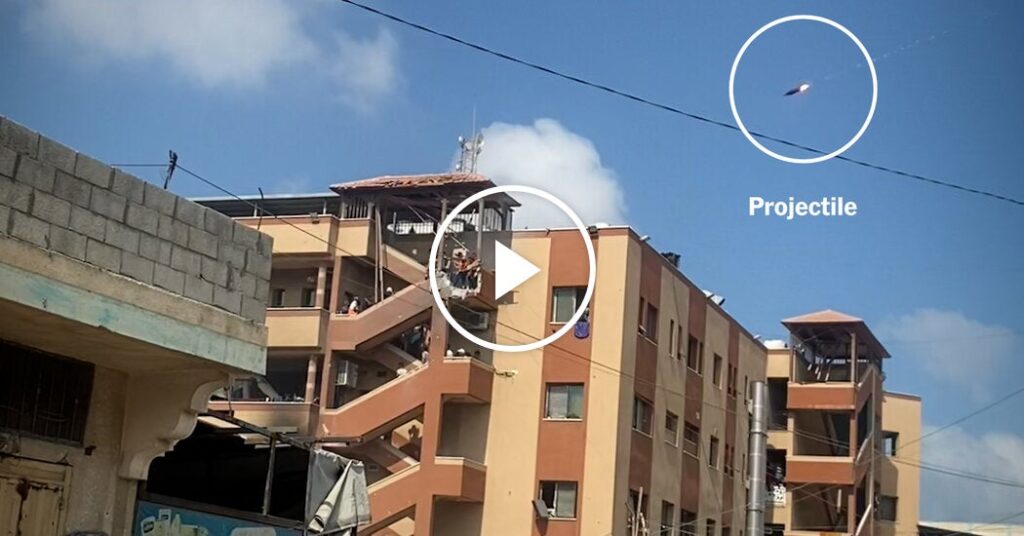new video loaded: Videos Contradict Israel’s Rationale for Deadly Hospital Attack
transcript
transcript
Videos Contradict Israel’s Rationale for Deadly Hospital Attack
The strikes on Nasser Hospital in Gaza killed at least 20 people. A Times visual analysis calls into question what the Israeli military was initially targeting there, and why its troops attacked a second time, killing first responders and journalists.
-
This is the moment before the Israeli military killed a group of journalists and rescue workers who were responding to a strike at a hospital in Gaza. [EXPLOSION] It was the second attack on that location in nine minutes, which was not only part of a hospital but also a well-established gathering spot for journalists. Hospitals, medical workers and the media are protected from attack under the laws of war. In total, at least 20 people were killed, including five journalists and four health workers. The Israeli military says it launched the attack to take out a Hamas-operated camera used to track its troops but did not provide any evidence of the type of camera in question, where it may have been located or why taking out a camera justified firing shells at a hospital and at journalists. [EXPLOSION] An analysis of visual evidence and footage from the scene raises questions about what they were targeting to begin with and why they launched a second attack that killed first responders and more journalists. Israel first struck the hospital in two separate locations, including this east-facing outdoor staircase, which has a view of the city and has frequently been used by journalists, including Mariam Abu Daqqa, an AP freelancer who appeared in this video from June. Journalists worked there, shot videos and photos, and hung out together. The Reuters news agency was running livestreams from that stairwell throughout the week before the attack. The Associated Press also recently ran livestreams there. The first attack killed at least two people, including Reuters cameraman Hussam al-Masri. These are the last moments al-Masri’s camera recorded. The picture and audio freeze at the moment of impact. Footage shows the immediate aftermath of the first attack, which also included a strike on a second location around the corner. It’s unclear why the Israeli military hit two separate staircases at a hospital when they only said they were targeting one Hamas-operated camera. Reuters journalist al-Masri’s camera is the only one that can be seen in the rubble in the east-facing stairway. Visuals of this staircase after the first attack do not appear to show any type of surveillance camera. Rescue workers and journalists rush up the stairs. Several first responders are wearing reflective vests. Here’s Mariam Abu Daqqa again and Hatem Khaled, a Reuters photographer. Khaled’s footage shows a chaotic rescue operation on the stairway with no sign of a military threat. Israeli troops fired again — [EXPLOSION] — about nine minutes after the initial attack. This second attack consisted of two projectiles that hit the same spot within a fraction of a second, killing most people on the stairway — [EXPLOSION] — including more journalists and several rescue workers. AP journalist Abu Daqqa was one of the victims. Reuters photographer Khaled was injured but survived. Soon after, Israeli Prime Minister Benjamin Netanyahu called the strikes a tragic mishap. In its initial inquiry, the military also claimed six Palestinian militants had been killed and said it is further investigating the decision-making around the attacks. The inquiry identified the unit involved as the Golani Brigade. It’s the same brigade that attacked and killed 15 Palestinian emergency workers in March. The Israeli military admitted to breaches of orders and dismissed one deputy commander, but no one was held criminally responsible for that attack. The military declined to answer further questions from The Times about the attacks on Nasser Hospital. The war in Gaza has been one of the deadliest modern conflicts for both journalists and medical workers. [MUSIC]
Recent episodes in Visual Investigations
Using evidence that’s hidden in plain sight, our investigative journalists present a definitive account of the news — from the Las Vegas massacre to a chemical attack in Syria.
Using evidence that’s hidden in plain sight, our investigative journalists present a definitive account of the news — from the Las Vegas massacre to a chemical attack in Syria.


